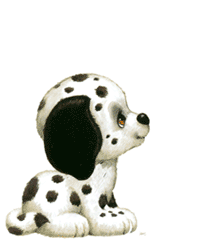This information is courtesey of The British Dalmatian Club Website. (August 2006)
We hope that you will find this interesting. A link is also available on the links page of this website.
If you need any further information, please do feel free to contact us.
When selecting a puppy do not rush. You are choosing a companion for up to 15 years. Find a reputable breeder and
arrange a visit to meet their dogs. This is likely to bring out all the boisterous behavior of the dogs and give a taste
of Dalmatian ownership! How did you feel about having 60lbs of dog in an enclosed room? Are you sure that you can cope
with white hair on clothes and furnishings!
Your district representative may assist you in meeting Dalmatians and their owners and also give details of shows where
you can see a number of Dalmatians together.
Members of the British Dalmatian Club are bound by the Clubs code of conduct regarding breeding practices. Details of
litters currently available can be found on the puppy list. This is a good place to start your search for a puppy. Be wary
of newspaper adverts, although many are quite OK, some are puppy farmers who care little about the health or hearing
status of their litters.
Be prepared for searching questions from the breeders as they try to ensure the pup is going to a suitable and caring home.
Cottage or castle, the owner and family should be of the right calibre. Beware of breeders who do not pursue the above
inquisition!
Ask the breeder what they are doing about having the puppies hearing tested (see the section on hearing under health
matters on this site for some important information). Obviously the dam and sire of the pups should have been hearing
tested (ask to see the test certificates) and be of superb temperament. These two requisites are always top of the list.
Visit puppies that are 5-6 weeks old when they will most resemble an adult dog. Pups should be square when stood up.
Keep an open mind on your preferences, as the pups will not have their hearing tested until they are at least 6 weeks old.
Make sure that you see the mother with the whole litter and that they are all lively and healthy.
Blue eyes, incomplete eye rims and patches are sometimes seen in litters. These are not destined for the show ring as
they are not within the breed standard, but are just as suitable as pets (and many people find them more distinctive).
Look for a pleasing pattern of spotting, preferably with no ticking. Personal preference on markings will come
into consideration.
Pups should be bold and playful. Their characters will be apparent even at this early stage
Ensure that you clarify the terms of the sale. Is the puppy insured
and Kennel Club registered? Has he been inoculated.
If so ensure that you receive the inoculation card to show to your vet. If he has not been
inoculated make this a priority,
through your vet, before he comes into
contact with dogs whose inoculation status is unknown or areas used by
them.
Ensure that you read the topic "Socialising your puppy".
The breeder should give you details of the food that your puppy is used to in advance of collecting him. It is advisable to
keep to the same food initially to avoid stomach upsets. You can change the diet gradually later if you so wish.
Meanwhile prepare the house and garden. A warm, safe puppy room (kitchen or utility) that is fairly busy so that the
pup is used to household activities. Make the garden absolutely dog proof.
|





























